Star Raiders
 The Game: Zylon warships are on the rampage, blasting allied basestars out of the sky and wreaking havoc throughout the galaxy. Your orders are to track down the fast-moving raiders and destroy them before they can do any more damage. You have limited shields and weapons at your disposal, and a battle computer which is vital to your mission (though critical damage to your space fighter can leave you without that rather important piece of equipment). The game is simple: destroy until you are destroyed, and defend friendly installations as long as you can. (Atari, 1979)
The Game: Zylon warships are on the rampage, blasting allied basestars out of the sky and wreaking havoc throughout the galaxy. Your orders are to track down the fast-moving raiders and destroy them before they can do any more damage. You have limited shields and weapons at your disposal, and a battle computer which is vital to your mission (though critical damage to your space fighter can leave you without that rather important piece of equipment). The game is simple: destroy until you are destroyed, and defend friendly installations as long as you can. (Atari, 1979)
Memories: The original version of Atari’s Star Raiders leaves very few doubts as to its origins; in a sense, it’s a new take on the old grid-based Star Trek mainframe game, only with ample opportunities for arcade-style action. Oh, and – astonishingly, even back then – the game kicks off with a title screen showing a spaceship obviously based on the Enterprise from Star Trek: The Motion Picture, which also appeared in 1979. How the lawyers missed that one, we’ll probably never know. [read more]

 The Game: You start the game by creating a character, Basic D&D style, who enters the world defenseless and just this side of naked. It’s your job to arm and armor your alter-ego, buy plenty of rations, and then set out to explore the world of Britannia, and the treacherous dungeons that lie beneath it. A visit to the castle of Lord British will give you a chance to level up for deeds accomplished, and receive an assignment from him for your next adventure. (California Pacific Computer, 1980)
The Game: You start the game by creating a character, Basic D&D style, who enters the world defenseless and just this side of naked. It’s your job to arm and armor your alter-ego, buy plenty of rations, and then set out to explore the world of Britannia, and the treacherous dungeons that lie beneath it. A visit to the castle of Lord British will give you a chance to level up for deeds accomplished, and receive an assignment from him for your next adventure. (California Pacific Computer, 1980)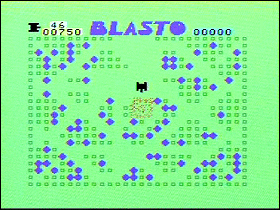 The Game: Piloting your mobile cannon around a cluttered playfield, you have but one task: clear the screen of mines, without blowing yourself up, in the time allotted. If you don’t clear the screen, or manage to detonate a mine so close to yourself that it takes you out, the game is over. If you do clear all the mines, you get a free chance to try it again. Two players can also try to clear the minefield simultaneously. (Texas Instruments, 1980)
The Game: Piloting your mobile cannon around a cluttered playfield, you have but one task: clear the screen of mines, without blowing yourself up, in the time allotted. If you don’t clear the screen, or manage to detonate a mine so close to yourself that it takes you out, the game is over. If you do clear all the mines, you get a free chance to try it again. Two players can also try to clear the minefield simultaneously. (Texas Instruments, 1980) The Game: You find yourself outside an inviting two-story house, and when you go in, you find several people waiting for you – and that inviting front door suddenly locked behind you. When dead bodies turn up on the second floor and night begins to fall (hope you found the matches in the cupboard already!), it quickly becomes apparent that among the friendly faces of the first floor is a cold-blooded killer. (On-Line Systems, 1980)
The Game: You find yourself outside an inviting two-story house, and when you go in, you find several people waiting for you – and that inviting front door suddenly locked behind you. When dead bodies turn up on the second floor and night begins to fall (hope you found the matches in the cupboard already!), it quickly becomes apparent that among the friendly faces of the first floor is a cold-blooded killer. (On-Line Systems, 1980) The Game: The enemy in an interplanetary war has gone underground, and you’re piloting the ship that’s taking the fight to him. But he hasn’t just hidden away in a hole; he’s hidden away in a very well-defended hole. As if it wasn’t already going to be enough of a tight squeeze navigating subterranean caverns on Mars, you’re now sharing that space with enemy ships and any number of other fatal obstacles. (Fortunately, the enemy also leaves copious numbers of helpful fuel depots for you too.) Once you fight your way to the bottom of the cave, you plant charges on the enemy mothership – meaning that now you have to escape the caverns again, and fast. (Atari, 1981)
The Game: The enemy in an interplanetary war has gone underground, and you’re piloting the ship that’s taking the fight to him. But he hasn’t just hidden away in a hole; he’s hidden away in a very well-defended hole. As if it wasn’t already going to be enough of a tight squeeze navigating subterranean caverns on Mars, you’re now sharing that space with enemy ships and any number of other fatal obstacles. (Fortunately, the enemy also leaves copious numbers of helpful fuel depots for you too.) Once you fight your way to the bottom of the cave, you plant charges on the enemy mothership – meaning that now you have to escape the caverns again, and fast. (Atari, 1981)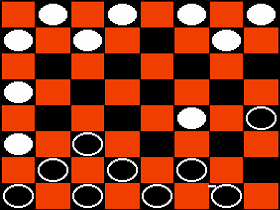 The Game: The classic game of strategy is faithfully reproduced on the Apple II. Two armies of twelve men each advance diagonally across the checkerboard, jumping over opponents and attempting to reach the enemy’s home squares to be crowned. Whoever still has pieces still standing at the end of the game wins. (Odessa Software, 1981)
The Game: The classic game of strategy is faithfully reproduced on the Apple II. Two armies of twelve men each advance diagonally across the checkerboard, jumping over opponents and attempting to reach the enemy’s home squares to be crowned. Whoever still has pieces still standing at the end of the game wins. (Odessa Software, 1981)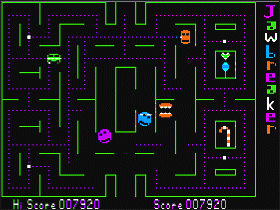 The Game: You’re a mobile set of chattering teeth, gobbling up goodies in a maze as jaw-breaking candies pursue you. If you bite down on one of these killer candies, you’ll rack up quite a dental bill (enough to lose a life). You can snag one of four snacks in the corners of the maze and suddenly the tooth-rotting treats become crunchy and vulnerable. Advance to the next level by clearing the maze of dots. (On-Line Systems, 1981)
The Game: You’re a mobile set of chattering teeth, gobbling up goodies in a maze as jaw-breaking candies pursue you. If you bite down on one of these killer candies, you’ll rack up quite a dental bill (enough to lose a life). You can snag one of four snacks in the corners of the maze and suddenly the tooth-rotting treats become crunchy and vulnerable. Advance to the next level by clearing the maze of dots. (On-Line Systems, 1981)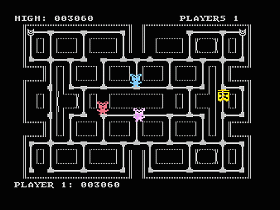 The Game: Plumber Larry Bain is out to earn his hazard pay, trying to run pipes through a rat-infested maze. This wouldn’t be a problem, except that the rats are as big as he is. He can lay a limited number of traps in the maze that will temporarily stop the rats in their tracks so he can double back and eliminate them, but in the end Larry’s best chance of survival is to stay on the run and fill the maze with plumbing. (Sierra On-Line, 1981)
The Game: Plumber Larry Bain is out to earn his hazard pay, trying to run pipes through a rat-infested maze. This wouldn’t be a problem, except that the rats are as big as he is. He can lay a limited number of traps in the maze that will temporarily stop the rats in their tracks so he can double back and eliminate them, but in the end Larry’s best chance of survival is to stay on the run and fill the maze with plumbing. (Sierra On-Line, 1981)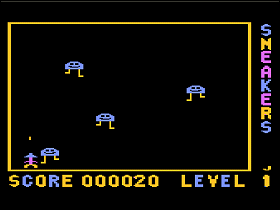 The Game: Alien invaders are descending on your world, taking on unusual forms in the process: sneaker-clad stomping creatures, roaming eyeballs, “H-wing fighters,” flying saucers and more. Try to use their unusual patterns of movement against them and keep them from destroying your fighter. (Sirius Software, 1981)
The Game: Alien invaders are descending on your world, taking on unusual forms in the process: sneaker-clad stomping creatures, roaming eyeballs, “H-wing fighters,” flying saucers and more. Try to use their unusual patterns of movement against them and keep them from destroying your fighter. (Sirius Software, 1981) The Game: As a round white creature consisting of a mouth and nothing else, and apparently somehow tied to the Internal Revenue Service, you maneuver around a relatively simple maze, gobbling small dots and evading four colorful monsters who can eat you on contact. In four corners of the screen, large flashing dots enable you to turn the tables and eat the monsters for a brief period for an escalating score. Periodically, assorted items appear near the center of the maze, and you can consume these for additional points as well. The monsters, once eaten, return to their home base in ghost form and, after spending some noncorporeal time floating around and contemplating taxation without representation, return to chase you anew. If cleared of dots, the maze refills and the game starts again, but just a little bit faster… (H.A.L. Labs, 1981)
The Game: As a round white creature consisting of a mouth and nothing else, and apparently somehow tied to the Internal Revenue Service, you maneuver around a relatively simple maze, gobbling small dots and evading four colorful monsters who can eat you on contact. In four corners of the screen, large flashing dots enable you to turn the tables and eat the monsters for a brief period for an escalating score. Periodically, assorted items appear near the center of the maze, and you can consume these for additional points as well. The monsters, once eaten, return to their home base in ghost form and, after spending some noncorporeal time floating around and contemplating taxation without representation, return to chase you anew. If cleared of dots, the maze refills and the game starts again, but just a little bit faster… (H.A.L. Labs, 1981)